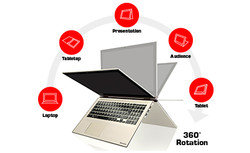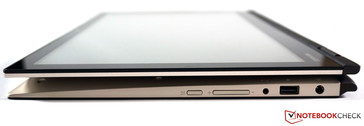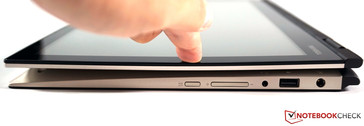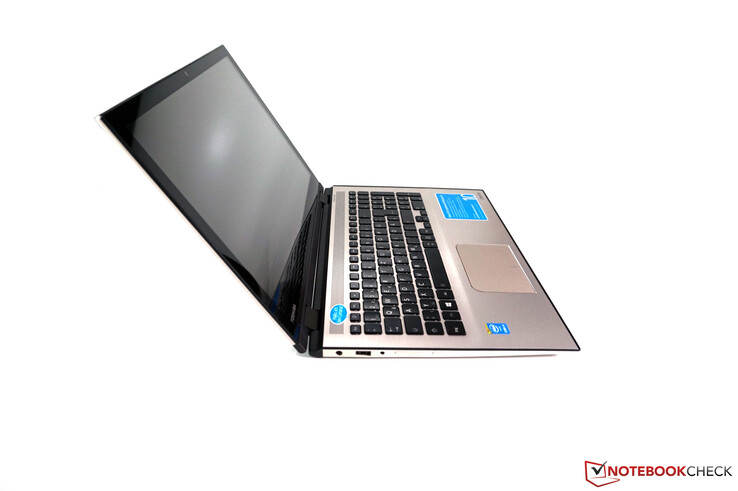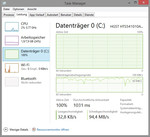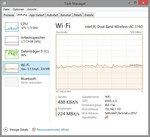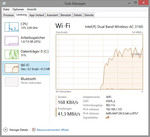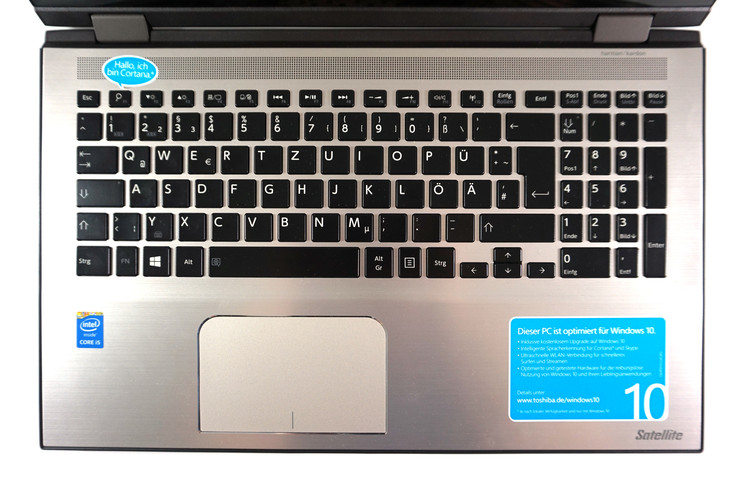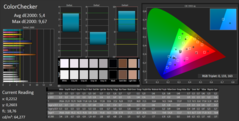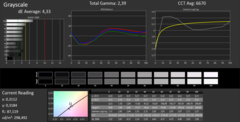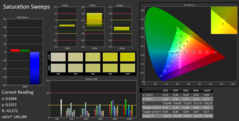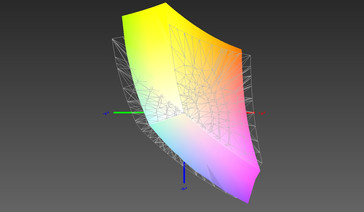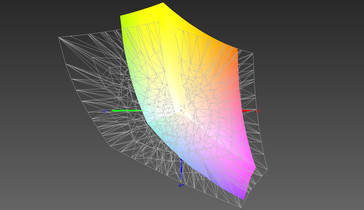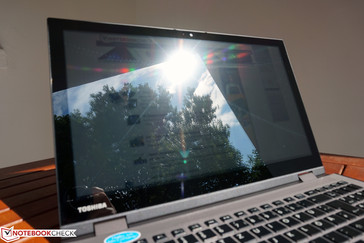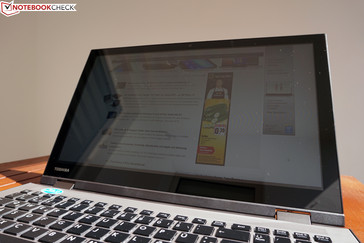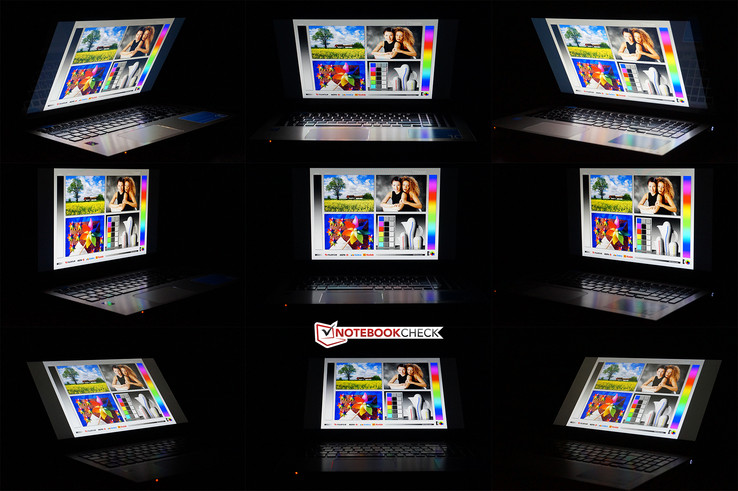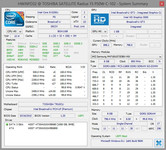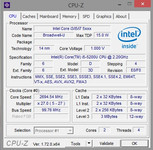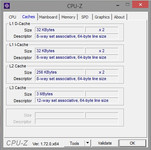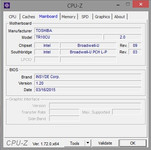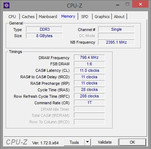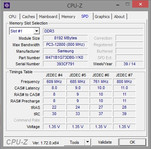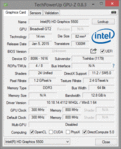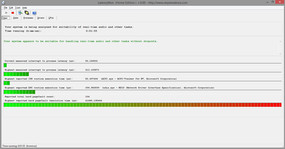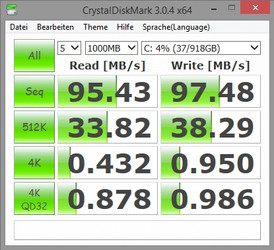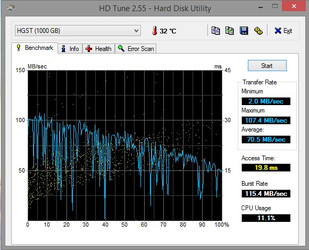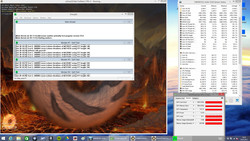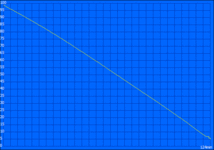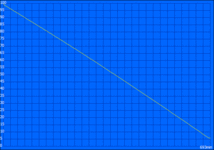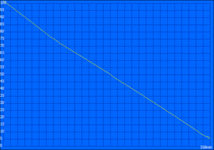Toshiba Satellite Radius 15 P50W-C Notebook Review

For the original German review, see here.
Almost every manufacturer offers convertibles nowadays, but the range is often limited to smaller notebooks with up to 13.3-inches. Only a handful of manufacturers like Lenovo or Asus, for example, also sell bigger models with flexible display hinges. Toshiba now also offers a convertible with a 15.6-inch screen called Satellite Radius 15, which is designed for private customers. It stands out from the competition with its golden chassis and wants to attract customers with its versatility.
Our review unit has the designation Satellite Radius 15 P50W-C-102 and is currently the only available configuration within the Radius 15-series in Germany. The RRP is 1,249 Euros (~$1391), which is a bit surprising when you look at the specifications. While other manufacturers offer quad-cores, dedicated graphics cards and SSDs for this price, the Radius 15 is only equipped with a frugal dual-core ULV processor with integrated GPU and a conventional 1 TB hard drive without SSD cache.
There are not many direct convertible rivals for the Satellite Radius 15. Lenovo sells the ThinkPad S5 Yoga, which also has a 15.6-inch display. It is, however, designed for business customers and is also a bit more expensive, but private customers can also have a look at the Yoga 3 14 with a slightly smaller screen. Other consumer devices like the Asus Transformer Book Flip TP500LN are much cheaper than our review unit. Can the Satellite Radius 15 justify its higher price?
Case
If you see the product pictures of the Toshiba Satellite Radius 15 for the first time, you will immediately notice the gold chassis. This quickly reminds us of the latest Apple products, which are also available in this color. However, the color called "Satin Gold" only creates a golden shimmer, and you might even think that you are using a silver device depending on the lighting. The design is therefore very noble and elegant, without looking too flashy. We like that, but you might be disappointed if you actually want a golden chassis. A surrounding black stripe on the base-unit and the display cover merges into the black section at the rear and creates a nice color contrast in combination with the black keyboard. Contrary to the gold-colored aluminum, however, the rear section is only made of pretty thick and textured plastic, which looks pretty cheap.
The 2.16 kg (according to Toshiba 2.24 kg) heavy and just 2 cm thin construction does not leave a very good impression in respect of the stability. While the palm rest is pretty sturdy, it is easy to dent the base-unit at the back and you can also hear creaking. The display cover is resistant against pressure and sturdy thanks to the glass cover, but the torsion resistance is low and it sounds like the glued connection inside the display would get loose.
The manufacturer uses 360-degree hinges, so the whole display can be folded back to use the different operating modes of the convertible. Those modes "Laptop," "Tabletop" (display at 180 degrees), "Presentation," "Audience" as well as "Tablet" do have other names, but the functionality does not differ from the familiar modes of Lenovo’s Yoga-series. The hinges are firm and it is not easy to open the lid with one hand, but they still have problems with the high weight of the display. Even small vibrations result in noticeable bouncing, which is particularly annoying in the laptop and stand mode (Toshiba calls it Audience mode). The keyboard was slightly lowered, so the keys won’t come into contact with the surface in the corresponding modes.
The Satellite Radius 15 can obviously also be used as a tablet, but that is not very comfortable with a weight of 2.16 kg. The keyboard is at the bottom in this case and is automatically deactivated, and it feels a bit strange when you use the device and your hands are lying on the keys, especially in the beginning. You can see a side effect of the rounded bottom chassis when you hold the tablet with both hands in landscape mode. Because of the resulting room to the base unit, it is possible to push down the side of the display (see picture), which also results in creaking. On the left side of the base-unit is a Windows button as well as a volume rocker. They are well-integrated into the chassis and improve the use of the tablet as well as the audience mode in particular.
The 45-Wh lithium-ion battery is not accessible from the outside and there is no maintenance hatch on the bottom, either.
Connectivity
The Toshiba Satellite Radius 15 only has the essential ports including three USB (1x USB 2.0, 2x USB 3.0), HDMI as well as an SD-card reader. The ports on the right side are very close to each other, which is why the adjacent ports can easily be blocked with large connectors or USB sticks. All in all, the port variety is not very comprehensive for a 15-inch notebook.
You cannot utilize the full potential of the ports due to the pretty slow conventional hard drive, because the maximum transfer rate is limited to around 95 MB/s. The USB 3.0 standard would be capable of much higher speeds in combination with fast SSDs.
Communication
The connection with the Internet is only possible via Wi-Fi, because there is no Ethernet port. There is no USB adaptor in the box, either, which could be used for wired networks. We already know the Wi-Fi module: Intel’s Dual-Band Wireless-AC 3160 supports all the common Wi-Fi standards, including the fast 802.11ac besides Bluetooth 4.0. The maximum transfer rate, however, is limited to 433 Mbps (1x1). There are already much faster modules, but it is still sufficient for common tasks. We could not determine any problems in practice with an Asus RT-AC56U router and measured around 220 Mbps (802.11 ac) and 40 Mbps (802.11 n), respectively, under perfect conditions (around 1 meter to the router). The module also supports Intel Wireless Display for the wireless transfer of the display content to corresponding receivers.
Above the display is an HD webcam that takes pictures and videos at 1280x720 pixels (videos @30 fps). You can already count the individual pixels under good lighting conditions. It is certainly sufficient to see the other person in a video chat, but you should avoid it for pictures. The integrated microphone leaves a better impression and records voices without noteworthy distortions.
Accessories
Besides the Satellite Radius 15, the box only contains a compact power adaptor, a quick-start guide as well as warranty information. Toshiba does not offer special accessories on its website, either, but it only advertises generic articles like bags, power adaptors or a USB-Ethernet adaptor (49 Euros, ~$54).
Maintenance
Maintaining the Satellite Radius 15 is a tricky thing. There are some screws on the bottom of the device that can be loosened, but the bottom cover still cannot be removed. We tried to open it with a sharp object, but that did not work. We stopped the attempt at this point to avoid any damage to the review unit. The manual also has a note that you should not open the device. You should contact the manufacturer or the retailer before you open the notebook to avoid warranty issues.
Warranty
The standard warranty period of the Satellite Radius 15 is 24 months. After registration through the Toshiba hotline, customers in Germany as well as Austria even get an On-Site pickup service. Toshiba also offers optional warranty extensions to 3 or 4 years as well as a three-year data recovery service in Europe that can be purchased via retailers.
Input Devices
Keyboard
Toshiba integrates a black chiclet keyboard with an additional numeric keypad and uses the available space pretty well. The normal keys are 16 x 16 mm, only the function keys as well as the keys of the numeric keypad are slightly smaller. Similar to many current notebooks, the arrow keys are only half-sized. The top row triggers the special functions like brightness or volume control by default, which means the normal F keys (F1 - F12) can only be used in combination with the Fn key. Toshiba uses dark-gray lettering for the secondary functions, which affects the contrast and therefore the visibility. You cannot see them at all when the background illumination is active. There are two settings for the illumination: Besides a continuous activation, there is a setting where the light is automatically deactivated when you don’t press a key for 15 seconds and is then activated again when you press a key. The whole keyboard area is slightly depressed, so the keys don’t touch the surface in the different operating modes.
The travel of the individual keys is not very generous, but inputs are still conveniently precise thanks to the firm pressure point. The typing noise is pretty quiet and rich for the majority of keys, but the bigger keys like the space bar or Return in particular tend to rattle. All in all, we had no problems to use the input and did not require any learning period, but you should not expect an excellent business keyboard.
Touchpad
The touchpad quickly turned out to be one of the biggest drawbacks of the Radius 15. The ClickPad of our review unit is very wobbly and does not seem to be attached correctly, which is why there are unpleasant rattling noises even when you tap it. You can also hear the touchpad when you use the keyboard. We suggest that this is an individual case, but we cannot confirm that without another test device. There were, however, no wrong inputs because of this.
The ClickPad with the integrated mouse buttons is provided by Synaptics and supports multi-touch gestures with up to four fingers. Those can be adjusted and activated/deactivated individually in the comprehensive driver. The pad is also large enough for inputs at 10.7 x 6.5 cm and fingers have no problems gliding across the smooth surface. The pad is slightly depressed in the palm rest and is therefore easy to find with the fingers.
Touchscreen
A real convertible is obviously equipped with a touchscreen. The capacitive panel in the Toshiba Satellite Radius recognizes up to 10 inputs simultaneously and offers very good gliding capabilities for the fingers. Our inputs were always executed reliably. There were some occasional delays, but they were not caused by the touchscreen but by the performance of the notebook. According to Toshiba, the touchscreen also has an anti-fingerprint coating. We could actually notice that fingerprints on the big panel are a much smaller issue than on a tablet like the Apple iPad Air, for example. It is also very easy to clean the screen with a cloth.
Display
Toshiba equips the Satellite Radius 15 with a 15.6-inch TrueBrite IPS display with LED background illumination. The native resolution of the 16:9 panel (LG Philips LP156WF6-SPA1) is 1920x1080 pixels, which results in a pixel density of 157 PPI. In combination with the large display, the resolution can still be used very well without scaling and represents a good compromise of sharp presentation and real estate. The screen is very glossy, but that is the case for almost every convertible.
Subjectively, the display leaves a decent impression. Colors are rich, black areas are really dark and the brightness is decent as well, even though it could be higher. Our measurements show an average luminance of 287 cd/m² and a good brightness distribution of 91%, but we would have liked to see a higher luminance in combination with the glossy display. Another problem is the fact that the brightness is reduced to 237 cd/m² on battery power. Still, the Radius 15 performs pretty well within the comparison, only the more expensive Lenovo ThinkPad S5 Yoga is a bit brighter. We could not determine screen bleeding, even in the peripheral areas.
| |||||||||||||||||||||||||
Brightness Distribution: 91 %
Center on Battery: 237 cd/m²
Contrast: 1172:1 (Black: 0.25 cd/m²)
ΔE ColorChecker Calman: 5.4 | ∀{0.5-29.43 Ø4.77}
ΔE Greyscale Calman: 4.33 | ∀{0.09-98 Ø5}
83% sRGB (Argyll 1.6.3 3D)
55% AdobeRGB 1998 (Argyll 1.6.3 3D)
60.8% AdobeRGB 1998 (Argyll 3D)
83.2% sRGB (Argyll 3D)
64.4% Display P3 (Argyll 3D)
Gamma: 2.39
CCT: 6670 K
| Toshiba Satellite Radius 15 P50W-C-102 HD Graphics 5500, 5200U, HGST Travelstar 5K1000 HTS541010A9E680 | Lenovo ThinkPad S5 Yoga 15 20DQ0038GE GeForce 840M, 5500U, Samsung SSD PM851 256 GB MZ7TE256HMHP | Asus Transformer Book Flip TP500LN GeForce 840M, 4210U, Seagate Momentus SpinPoint M8 ST1000LM024 HN-M101MBB | Lenovo Yoga 3 14 HD Graphics 5500, 5200U, Samsung SSD PM851 256 GB MZYTE256HMHP | Dell Inspiron 15-7548 Radeon R7 M270, 5500U, Liteon IT LCS-256L9S-11 | |
|---|---|---|---|---|---|
| Display | -17% | ||||
| Display P3 Coverage (%) | 64.4 | 49.85 -23% | |||
| sRGB Coverage (%) | 83.2 | 73.3 -12% | |||
| AdobeRGB 1998 Coverage (%) | 60.8 | 51.7 -15% | |||
| Screen | -29% | -24% | -21% | -61% | |
| Brightness middle (cd/m²) | 293 | 314 7% | 154 -47% | 234.6 -20% | 214 -27% |
| Brightness (cd/m²) | 287 | 279 -3% | 143 -50% | 225 -22% | 204 -29% |
| Brightness Distribution (%) | 91 | 84 -8% | 84 -8% | 82 -10% | 77 -15% |
| Black Level * (cd/m²) | 0.25 | 0.5 -100% | 0.3 -20% | 0.394 -58% | 0.76 -204% |
| Contrast (:1) | 1172 | 628 -46% | 513 -56% | 595 -49% | 282 -76% |
| Colorchecker dE 2000 * | 5.4 | 5.93 -10% | 4.84 10% | 5.22 3% | 5.83 -8% |
| Greyscale dE 2000 * | 4.33 | 6.22 -44% | 4.53 -5% | 3.35 23% | 7.17 -66% |
| Gamma | 2.39 92% | 2.58 85% | 2.22 99% | 2.27 97% | 1.94 113% |
| CCT | 6670 97% | 5647 115% | 7307 89% | 6184 105% | 5617 116% |
| Color Space (Percent of AdobeRGB 1998) (%) | 55 | 48 -13% | 36.92 -33% | ||
| Color Space (Percent of sRGB) (%) | 83 | ||||
| Total Average (Program / Settings) | -29% /
-29% | -21% /
-22% | -21% /
-21% | -61% /
-61% |
* ... smaller is better
Our measurements with the professional software CalMAN confirm our good subjective impression. Thanks to the low black value of just 0.25 cd/m², the contrast is higher than 1,100:1, which easily beats the rivals. But this result is not only very good in this comparison group. We can measure average deviations of 5.4 for the colors as well as 4.33 for the grayscale ex-works with the reference color space sRGB. Ideal values would be smaller 3, but you also need trained eyes to see deviations with the measured values. The gamma value of 2.39 almost corresponds with the ideal value of 2.4. It is also fortunate that there is no visible blue cast.
Our panel can cover the sRGB as well as AdobeRGB color spaces by 83% and 55%, respectively, and it is therefore not really suited for (semi) professional picture editing. But you do not have to expect limitations with common tasks.
You always have to fight with the reflections of the glossy display outdoors. Depending on the background, there can even be problems indoors and you should certainly avoid direct sunlight. The background illumination is not powerful enough to compensate for the reflections and the display luminance is even reduced to 237 cd/m² on battery power. It is still possible to use the device when you choose a good position (no light sources in the back, in the shade, etc.).
The viewing-angle stability is on a typically high level for an IPS display. Only extreme viewing angles will result in a reduced contrast and there is also a slight gray hue. You can also see double contours from very flat angles due to the distance between the glass and the display itself. However, this is moaning at a high level.
Performance
Toshiba only offers one configuration of the Satellite Radius 15 in Germany, which is equipped with a current Intel Core i5 processor including integrated graphics card, 8 GB memory (1x 8 GB DDR3L-1600, single-channel) as well as a 1 TB hard drive. The performance is therefore comparable to many smaller notebooks. It is sufficient for simple tasks like text editing, web browsing or even light multimedia applications, but after that you will quickly reach its limits.
Processor
The i5-5200U is a dual-core processor from Intel’s current Broadwell generation. Thanks to its low power consumption (TDP) of just 15 Watts, the chip is also suited for thin constructions. The nominal clock is pretty low at 2.2 GHz but can be raised to 2.7 GHz when you stress one core (2.5 GHz for two cores). The processor also supports Hyper-Threading, so the dual-core can execute up to four threads simultaneously.
The performance of current ULV processors is completely sufficient for normal tasks, which is why these chips are often used in bigger 15-inch devices nowadays and not only in compact subnotebooks and ultrabooks. All our comparison devices are equipped with frugal i5 or i7 processors as well.
Our benchmark results for the dual-core are on the expected level. The slightly faster Core i7-5500U in the Lenovo ThinkPad S5 Yoga and the Dell Inspiron 15 is roughly 10% faster in Cinebench R15 (Single & Multi). The older Core i5-4210U in the Asus Transformer Book Flip TP500LN falls behind the Core i5 in our review unit by around 10% (Multi) and 20% (Single) depending on the scenario. Our Radius 15 can utilize its full Turbo Boost potential, which is also the case on battery power.
More benchmarks and information for the Core i5-5200U are available in our Tech section.
| Cinebench R10 | |
| Rendering Single CPUs 64Bit (sort by value) | |
| Toshiba Satellite Radius 15 P50W-C-102 | |
| Lenovo Yoga 3 14 | |
| Rendering Multiple CPUs 64Bit (sort by value) | |
| Toshiba Satellite Radius 15 P50W-C-102 | |
| Lenovo Yoga 3 14 | |
System Performance
We use the benchmarks of the PCMark-series to evaluate the general system performance. The tests not only evaluate the processor but also the graphics card, the memory as well as the hard drive. The conventional hard drive has a negative effect, particularly in PCMark 7, where the Satellite Radius 15 is 50% slower than the Asus Transformer Book Flip with a hybrid hard drive. The deficit to the SSD-based rivals is even bigger (74 - 104%). However, the comparison devices are very similar and only differ by a couple of percentage points in the newer PCMark 8, which sets other priorities in the tests.
Subjectively, the pretty fresh system leaves a decent impression. There are delays when you launch applications and the boot time is also longer compared to systems with SSDs, but our system still does not feel sluggish. This could, however, change with increasing operating time and filling of the hard drive.
| PCMark 7 - Score (sort by value) | |
| Toshiba Satellite Radius 15 P50W-C-102 | |
| Lenovo ThinkPad S5 Yoga 15 20DQ0038GE | |
| Asus Transformer Book Flip TP500LN | |
| Lenovo Yoga 3 14 | |
| Dell Inspiron 15-7548 | |
| PCMark 7 Score | 2652 points | |
| PCMark 8 Home Score Accelerated v2 | 2841 points | |
| PCMark 8 Work Score Accelerated v2 | 3676 points | |
Help | ||
Storage Solution
The Toshiba Satellite Radius 15 uses a 1 TB hard drive (HGST Travelstar 5K1000). You can use around 885 GB from the gross capacity of 1000 GB, which means this drive with 5,400 rpm is perfectly suited as a data drive, but it cannot compete with SSDs as a primary system drive. You can at least expect a small SSD as a system drive for a device with a price of more than 1,200 Euros (~$1336). Even the pretty empty drive with the still fresh Windows installation only manages an average transfer rate of 70 MB/s and an access time of more than 19 ms according to HD Tune. These results should be worse after some time of use. Our continuously growing HDD/SSD list can be used for comparisons with other hard drives.
GPU Performance
Contrary to some of the comparison devices, the Radius 15 does not use a dedicated graphics card. Instead, the whole graphics output is handled by the integrated Intel HD Graphics 5500 that runs at 900 MHz (core). The GPU cannot utilize its full potential due to the single-channel memory configuration. The review unit is on par with the similarly equipped Lenovo Yoga 3 14 in the current 3DMark Fire Strike test, but the other devices with an additional graphics card are at least twice as fast.
More information and benchmarks about the Intel HD Graphics 5500 are available here.
| 3DMark 11 - 1280x720 Performance (sort by value) | |
| Toshiba Satellite Radius 15 P50W-C-102 | |
| Asus Transformer Book Flip TP500LN | |
| Lenovo Yoga 3 14 | |
| Dell Inspiron 15-7548 | |
| 3DMark 06 - 1280x1024 Standard Score AA:0x AF:0x (sort by value) | |
| Toshiba Satellite Radius 15 P50W-C-102 | |
| Lenovo Yoga 3 14 | |
| Dell Inspiron 15-7548 | |
| 3DMark 06 Standard Score | 6086 points | |
| 3DMark 11 Performance | 1005 points | |
| 3DMark Ice Storm Standard Score | 42122 points | |
| 3DMark Cloud Gate Standard Score | 4438 points | |
| 3DMark Fire Strike Score | 601 points | |
Help | ||
Gaming Performance
Normal desktop games only run smoothly on the Satellite Radius 15 in low resolutions and with reduced details, but the gameplay will stutter even at medium settings. Titles from the Windows Store, which can also be played with the touchscreen and run smoothly, provide a better experience. Information about the requirements of many games is available in our Tech section.
| Tomb Raider | |
| 1024x768 Low Preset (sort by value) | |
| Toshiba Satellite Radius 15 P50W-C-102 | |
| Dell Inspiron 15-7548 | |
| 1366x768 Normal Preset AA:FX AF:4x (sort by value) | |
| Toshiba Satellite Radius 15 P50W-C-102 | |
| Dell Inspiron 15-7548 | |
| 1366x768 High Preset AA:FX AF:8x (sort by value) | |
| Toshiba Satellite Radius 15 P50W-C-102 | |
| Dell Inspiron 15-7548 | |
| F1 2014 | |
| 1024x768 Ultra Low Preset (sort by value) | |
| Toshiba Satellite Radius 15 P50W-C-102 | |
| Dell Inspiron 15-7548 | |
| 1366x768 Medium Preset (sort by value) | |
| Toshiba Satellite Radius 15 P50W-C-102 | |
| Dell Inspiron 15-7548 | |
| 1920x1080 High Preset (sort by value) | |
| Toshiba Satellite Radius 15 P50W-C-102 | |
| Dell Inspiron 15-7548 | |
| 1920x1080 Ultra Preset AA:4x MS (sort by value) | |
| Toshiba Satellite Radius 15 P50W-C-102 | |
| Dell Inspiron 15-7548 | |
| BioShock Infinite | |
| 1280x720 Very Low Preset (sort by value) | |
| Toshiba Satellite Radius 15 P50W-C-102 | |
| Lenovo ThinkPad S5 Yoga 15 20DQ0038GE | |
| 1366x768 Medium Preset (sort by value) | |
| Toshiba Satellite Radius 15 P50W-C-102 | |
| Lenovo ThinkPad S5 Yoga 15 20DQ0038GE | |
| 1366x768 High Preset (sort by value) | |
| Toshiba Satellite Radius 15 P50W-C-102 | |
| Lenovo ThinkPad S5 Yoga 15 20DQ0038GE | |
| low | med. | high | ultra | |
|---|---|---|---|---|
| Tomb Raider (2013) | 44.2 | 22 | 14 | |
| BioShock Infinite (2013) | 30.5 | 18 | 14.6 | |
| F1 2014 (2014) | 39 | 27 | 18 | 12 |
Emissions
System Noise
The Satellite Radius 15 is a very quiet companion in operation. The fan is not deactivated while idling but is only audible in very quiet environments at 32.9 dB(A). The slow 5,400 rpm hard drive is an advantage in this situation, which is not as loud as many faster models. Our measurements determine 37.1 dB(A) under medium workloads, but this is not really annoying thanks to the restrained noise characteristics (no whining, no high tones). The maximum volume of 43.1 dB(A) will only be reached after 15 minutes in our stress test and should therefore not be a big issue in practice. The fan quickly slows down again after the load period has stopped.
Noise level
| Idle |
| 32.9 / 32.9 / 32.9 dB(A) |
| Load |
| 37.1 / 43.1 dB(A) |
 | ||
30 dB silent 40 dB(A) audible 50 dB(A) loud |
||
min: | ||
Temperature
The surface temperatures of our review unit are not critical with less than 30 °C on average both on the top and the bottom while idling. We can see the highest values under load at the back and there is a central hotspot in the area of the fan opening, where we can measure almost 46 °C at the bottom. This is clearly perceptible, but you usually don’t touch this spot during operation, which is also the case for the other operating modes of the Satellite Radius 15. The palm rest is always comfortable, also under load.
We cannot determine any issues with the temperatures of the components either. The maximum temperature of the processor was 78 °C during our stress test (Prime95 and FurMark for at least one hour), and even just 65 °C when we only stress the CPU with Prime95. Our stress test is usually a problem for the ULV hardware, which results in a performance reduction because of a reduced clock (throttling). This is not the case for the Satellite Radius 15, because the manufacturer allows the processor to surpass its TDP limit of 15 Watts permanently (around 18-20 Watts). This means both the processor as well as the graphics card can execute the stress test with their full performance (CPU: 2.5 GHz, GPU: 900 MHz), both on mains as well as battery power.
The cooling solution of the Satellite Radius 15 does not seem to have a problem with the resulting heat, so this is a sensible decision by Toshiba.
(±) The maximum temperature on the upper side is 41.6 °C / 107 F, compared to the average of 35.4 °C / 96 F, ranging from 19.6 to 60 °C for the class Convertible.
(-) The bottom heats up to a maximum of 45.8 °C / 114 F, compared to the average of 36.8 °C / 98 F
(+) In idle usage, the average temperature for the upper side is 29.2 °C / 85 F, compared to the device average of 30.3 °C / 87 F.
(+) The palmrests and touchpad are reaching skin temperature as a maximum (32 °C / 89.6 F) and are therefore not hot.
(-) The average temperature of the palmrest area of similar devices was 27.9 °C / 82.2 F (-4.1 °C / -7.4 F).
Speakers
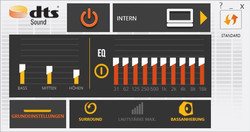
Above the keyboard is a perforated speaker grille, which suggests a decent sound in combination with the Harman/Kardon lettering. This is, however, a visual trick, because the two speakers are only on the left and right sides; the rest is for the design. Toshiba also installs the additional DTS sound software, which can be used to improve the sound.
The first impression of the two modules is mixed, because the high maximum volume is accompanied by a pretty thin sound. The position of the speakers does create a certain stereo effect during gaming and movie playback, but bass is not available. The sound gets a bit richer with the activated software but also distorts quickly at higher volumes. Besides different profiles you can also use an equalizer, so you can adjust the sound according to your preferences. All in all, not a great performance but sufficient for occasional movie and music playback. The layout of the speakers works well in the traditional laptop mode, but they are faced away from the user or damped by the base in the other operating modes.
External speakers or headphones can either be connected via HDMI, Bluetooth or the 3.5 mm stereo jack. The latter is sufficiently loud and provides a low-noise playback. The software automatically activates the corresponding profile when you attach headphones, and we actually liked it. The connection with a Bluetooth speaker (Denon Envaya Mini) was no problem and there were no delays during the playback, either.
Energy Management
Power Consumption
The power consumption is okay for a device with a 15.6-inch display. We can measure a maximum consumption of 36 Watts under load. ULV systems usually max out at around 30 Watts. The bigger display obviously affects the consumption as well, but our result once again shows that the CPU can surpass its TDP limit of 15 Watts (see Temperature section). The notebook does not consume any power when it is turned off and just 0.2 Watts during standby.
The very compact 45-Watt power adaptor (139 grams) is sufficient for the maximum power consumption of the Satellite Radius 15.
| Off / Standby | |
| Idle | |
| Load |
|
Key:
min: | |
Battery Runtime
Our review unit is average within the comparison group in respect of the battery runtimes. We determined around 11.5 hours under perfect conditions (Battery Eater Reader’s Test, minimum brightness, energy-saving mode, wireless modules off). You can expect at least two hours under load (Battery Eater Classic Test, maximum brightness, high-performance mode, wireless modules on). The two devices from Lenovo in particular last longer in these scenarios.
However, the two tests with an adjusted brightness at around 150 cd/m² are more interesting. Our Wi-Fi test opens a new website every 40 seconds, while the power profile "Balanced" is active and the wireless modules are turned on. Six hours is a decent result for the Satellite Radius 15 and only the Lenovo ThinkPad S5 Yoga lasts another hour, while the Dell Inspiron 15 has to be charged 1.5 hours sooner. The Asus Transformer Book Flip was still tested with the old Wi-Fi test that was not quite as demanding, but even the runtime in the old test was noticeably shorter. Video playback (Big Buck Bunny, 1080p, H.264) is possible for around 5.5 hours.
A complete charge of the 45-Wh battery (remaining capacity 5%) takes around three hours when the notebook is turned on. However, 80% of the capacity is available after around two hours.
| Toshiba Satellite Radius 15 P50W-C-102 HD Graphics 5500, 5200U, HGST Travelstar 5K1000 HTS541010A9E680 | Lenovo ThinkPad S5 Yoga 15 20DQ0038GE GeForce 840M, 5500U, Samsung SSD PM851 256 GB MZ7TE256HMHP | Asus Transformer Book Flip TP500LN GeForce 840M, 4210U, Seagate Momentus SpinPoint M8 ST1000LM024 HN-M101MBB | Lenovo Yoga 3 14 HD Graphics 5500, 5200U, Samsung SSD PM851 256 GB MZYTE256HMHP | Dell Inspiron 15-7548 Radeon R7 M270, 5500U, Liteon IT LCS-256L9S-11 | |
|---|---|---|---|---|---|
| Battery runtime | 30% | -42% | 40% | -25% | |
| Reader / Idle (h) | 11.6 | 18.2 57% | 7.5 -35% | 19.7 70% | 10.6 -9% |
| H.264 (h) | 5.6 | 3.9 -30% | 4 -29% | ||
| WiFi v1.3 (h) | 6 | 6.9 15% | 4.4 -27% | ||
| Load (h) | 2.1 | 2.5 19% | 0.8 -62% | 2.3 10% | 1.4 -33% |
| WiFi (h) | 4.6 | 7.8 |
Pros
Cons
Verdict
Does the flexible chassis design also work for a big 15.6-inch device? Basically yes, but the Toshiba Satellite Radius 15 still leaves a pretty mixed impression in our review. Some basic characteristics like the stability, the build quality and the system performance in particular reveal some drawbacks. This should not be the case with the comparatively high price. The biggest issue during our test, however, was the wobbly ClickPad that affected the whole operation.
We liked the good characteristics of the display, and the high contrast in particular is very good. The Radius 15 is also one of the few ULV notebooks that does not reduce the performance even in our stress test, because the processor can exceed its TDP limit permanently. The speakers are decent and the touchscreen enables a very versatile usage in combination with the different operating modes. Only the comparatively high weight can affect the tablet mode.
The Satellite Radius 15 is a very versatile device, which can convince us in some areas, but it reveals too many weaknesses for the pretty high price.
For an RRP of 1,249 Euros (~$1391), the Satellite Radius 15 just cannot meet our expectations. The rivals are either equipped with SSDs or hybrid hard drives and sometimes even with dedicated graphics cards, so they are more powerful and can be used for even more scenarios (light gaming, for example). In some cases they are even available for a lower price.
Toshiba Satellite Radius 15 P50W-C-102
- 08/06/2015 v4 (old)
Andreas Osthoff


